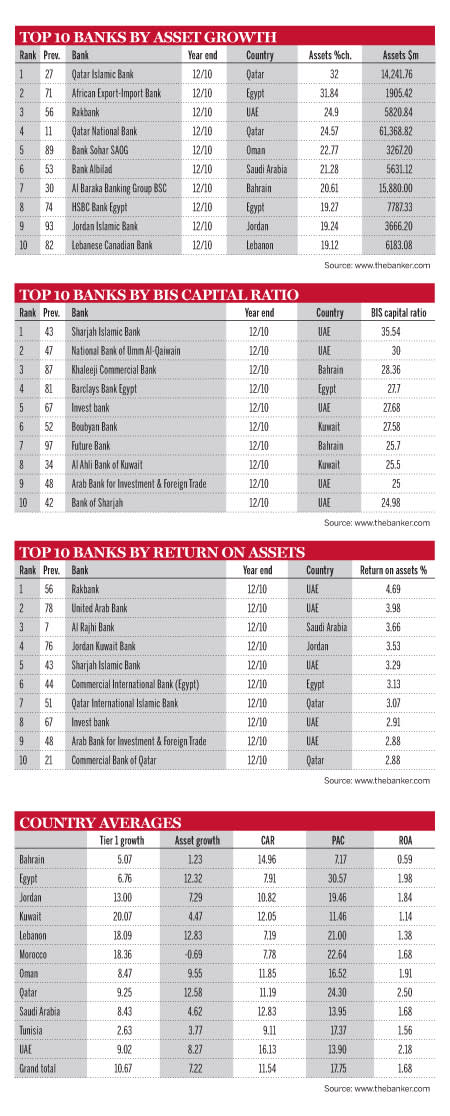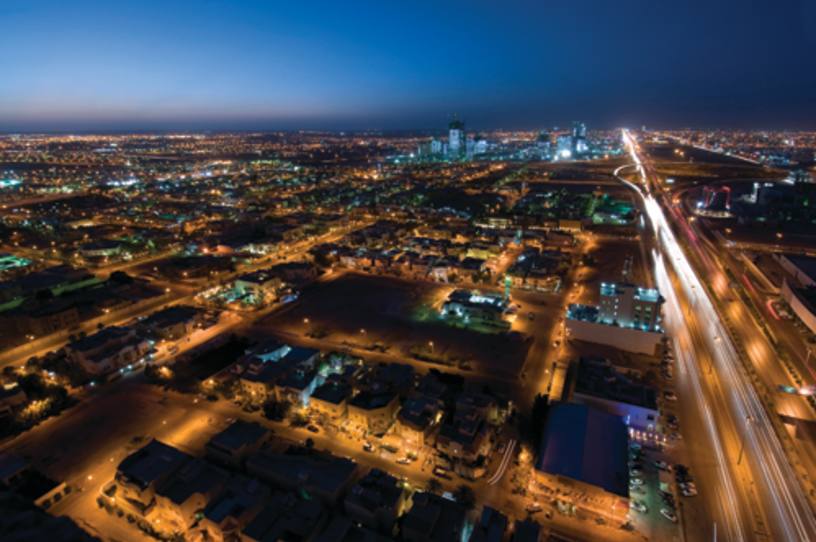Largely speaking, 2010 proved to be a year of positive growth for Arab banks around the world. This year’s ranking of the top 100 Arab banks shows their total assets grew by 4.8% from $1514bn at the end of 2009 to $1587bn by the end of 2010.
Seven banks grew their assets by more than 20%. Two of these expanded their assets by more than 30% – Qatar Islamic Bank and Egypt’s African Export-Import Bank both grew their assets by 32%.
Editor's choice
Heavyweight Saudi Arabian and United Arab Emirates banks continued to dominate the rankings – comprising seven of the 10 largest banks both by asset size and Tier 1 capital. The UAE’s Emirates NBD has the largest asset base of $77.92bn, while Saudi Arabia’s National Commercial Bank has the highest Tier 1 capital of $8.31bn.
Healthy signs
Considered the core measure of a bank’s financial strength from a regulatory point of view, Tier 1 capital is a good barometer of a bank's health. The overall Tier 1 capital of the 100 Arab banks in this ranking has grown a healthy 8.7% from $153.5bn in 2009 to $166.9bn in 2010.
Meanwhile, aggregate pre-tax profits recorded strong growth of 11.5% year on year to $25.99bn, with mean profits on average capital standing at 17.75%, and average return on assets at 1.68%.
Six Arab banks declared profits of more than $1bn, led by Saudi Arabia’s Al Rajhi Bank, the world’s largest Islamic bank by asset size, which achieved profits of $1.806bn. It was joined by fellow Saudi lenders National Commercial Bank ($1.28bn) and Samba Financial Group ($1.18bn), as well as Qatar National Bank ($1.57bn), National Bank of Kuwait ($1.14bn) and the UAE’s National Bank of Abu Dhabi ($1.03bn).
Record breakers
Four countries stand out for posting profits on average capital (PAC) of more than 20%. Egypt led the way with a PAC ratio of 30.57%, followed by Qatar with 24.3%, Morocco with 22.64% and Lebanon with 21%.
Within these countries, several banks deserve a special mention for noticeably outperforming their peers: HSBC Bank Egypt posted a PAC ratio of 46.92%, Qatar National Bank’s PAC ratio stood at 36.92%, while Morocco’s Attijariwafabank recorded a PAC ratio of 31.49%. All three banks stood within the top 10 banks ranked by this indicator.
Only two banks in this year’s top 100 Arab ranking reported a loss. Bahrain’s BankMuscat International posted steep losses of $70.44m after exposure to debt-laden Saudi conglomerates Saad Group and Al-Gosaibi. Meanwhile, Bahrain’s Khaleeji Commercial Bank recorded the bank’s first ever loss of $17.38m; which in 2009 made a profit of $8.22m. This was as a result of increasing its impairment provision by $22.8m.
Egyptian banks stand out for scoring a high return on capital, comprising six of the top 10 banks ranked by this indicator. HSBC Bank Egypt spearheaded this trend with pre-tax profits equal to 46.92% of average capital – the highest percentage within the entire ranking – while well-known players Commercial International Bank, National Bank of Egypt and Crédit Agricole Egypt also featured.
The UAE’s Rakbank slipped to second place in this year’s ranking with profits equivalent to 41.92% of average capital but climbed a position to gain the number one spot in return on assets which stand at 4.69%. In fact, UAE banks put their assets to good use in 2010, with five of the country's banks ranking within the top 10 lenders by return on assets.

Increase in soundness
The average capital-to-assets ratio – a measure of a bank’s ability to absorb a reasonable amount of loss – among banks in this year’s ranking stands at 11.54%, marginally higher than the 11.32% recorded based on 2009 figures. Arab banks are well capitalised in comparison to their Western counterparts – the aggregate capital assets ratio of western European and North American banks stood at a respective 4.28% and 7.30% at the end of 2010, according to The Banker’s Top 1000 World Banks ranking.
UAE and Bahraini banks score particularly highly on this front – with nine of the top 10 banks ranked by this indicator coming from the two countries.
Bahrain’s Khaleeji Commercial Bank’s capital adequacy ratio stood at 28.16% at the end of 2010, while the UAE’s Sharjah Islamic Bank and the National Bank of Umm Al-Qaiwain rank a respective second and third with ratios of 24.78% and 24.61%. Such high capital adequacy ratios reflect both higher liquidity flow but also reduced lending due to an overly cautious approach of the banks in these countries.

Real-estate bubble
Indeed, bank lending in the UAE edged up by a mere 2.6% in the 12-month period to the end of July 2011 to Dh1052bn ($286.4bn), a month-on-month decline of 0.4%, owing to cautiousness and low demand from the private sector.
The UAE banking sector in particular has suffered a spike in non-performing loans on the back of its high exposure to the property market, where the bursting of Dubai’s real estate bubble sent asset values plummeting by up to 50%.
Total provisions in the UAE increased to Dh63.5bn at the end of July 2011, up 24% from Dh51.3bn a year ago, and comprising about 6% of total lending.
Of the figures available, banks’ aggregate non-performing loans (NPL) as a percentage of total loans stood at 5.2%, reflecting a weakness in their overall asset quality. Banks are continuing to set aside provisions to work at trimming these bad debts going forward.
At $346.9bn, Saudi Arabian banks continue to hold the lion’s share of assets across the Middle East, followed by UAE banks with $334.2bn and Kuwaiti banks with $162.6bn.
However, while Saudi Arabia’s banks generated the largest overall profit ($7.02bn) and the UAE banks the second largest profits ($4.49bn), Kuwaiti banks rank fifth in overall country banking sector profitability – equivalent to $2.1bn. They are preceded by Qatari and Egyptian banks with respective profits of $3.11bn and $2.46bn.
Credit exposure
The Kuwait banking sector has high credit exposures of 11% and 25% to real-estate and investment companies, respectively, both of which have suffered a decline in their values. However, set against the backdrop of the ongoing global financial crisis, the fact that Arab banks have collectively boosted both their assets and profits by quite notable margins is impressive.
Looking forward, the political uprisings seen across the Middle East and north Africa region this year, many of which are still ongoing, will inevitably have an impact on the asset quality and profitability of the banks that have operations or investment exposures in these countries. The troubled US economy and continuing eurozone crisis will also weigh down their performance this year. But the key performance indicators of this year’s ranking bear testimony to the fact that the Arab banking sector is on an upward growth trajectory.





